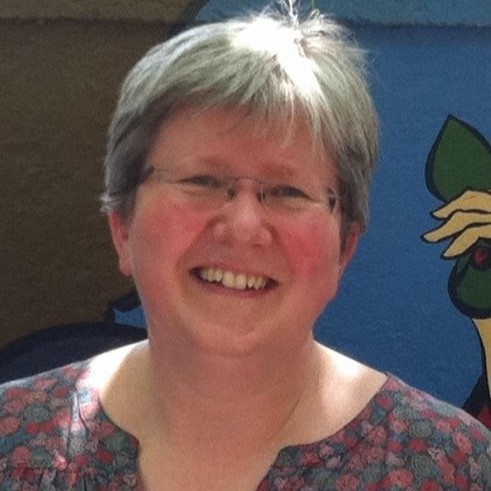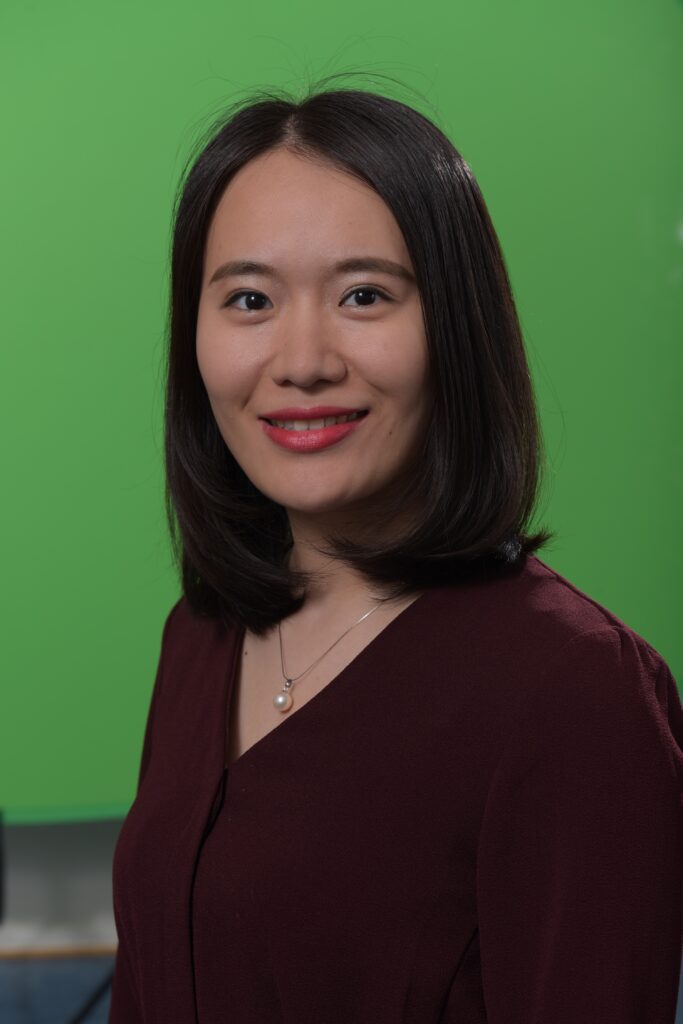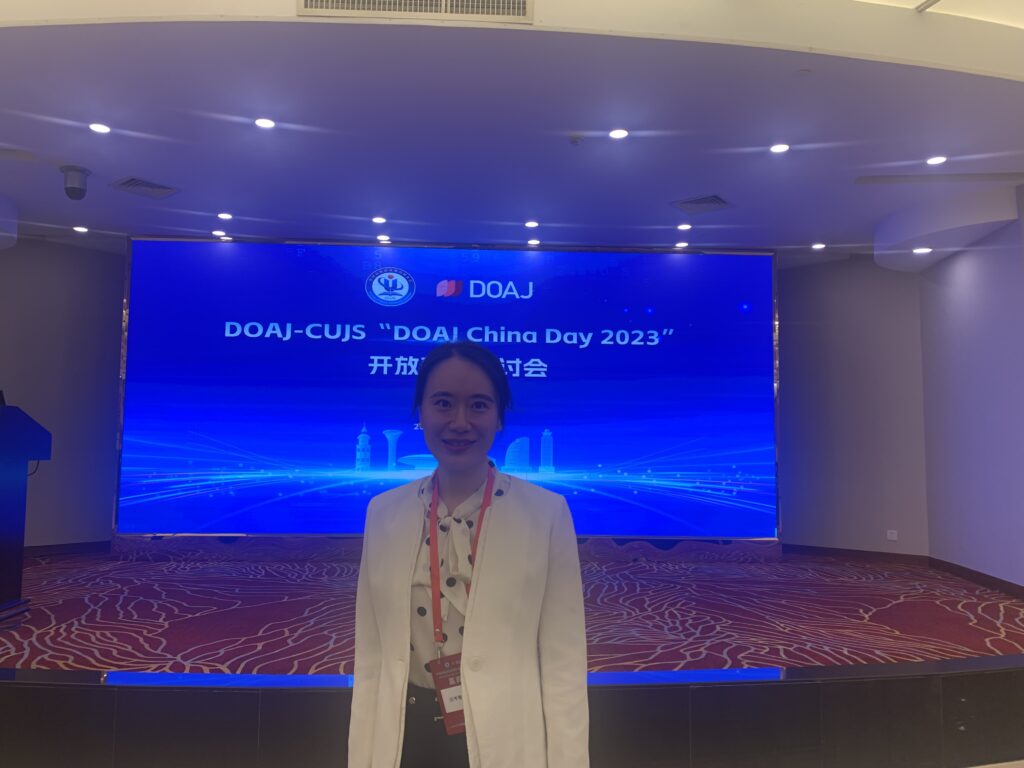You might have wondered how many people are behind the scenes at DOAJ and what they do. This blog post series will offer our community an opportunity to meet several of our team members and learn more about their roles and responsibilities. In this blog post, we will meet Judith Barnsby, Head of Editorial and Cenyu Shen, Deputy Head of Editorial (Quality).

Judith, you’re Head of Editorial – tell us a bit about your role and your background?
Judith: I lead the editorial team of 12 people who are responsible for reviewing journals for inclusion in DOAJ. My background is in publishing, working for not-for-profit publishers in the UK, and for publishing service providers, hosting journals from a wide range of publishers in various countries.. I came to DOAJ initially on a temporary contract in 2015, and I am still here!
Cenyu, you’re Deputy Head of Editorial (Quality) – tell us a bit about your role and your background?

Cenyu: I lead DOAJ’s Quality team to combat questionable journals and publishers by developing processes and strategies. I also manage our workflow efficiently to make sure the quality team can meet the high standards of our investigations. I have a background as a researcher specialising in scholarly communications and open access. In my research I’ve focused on various aspects of open access publishing using bibliometrics, case studies and other research methods. I’ve had a particular focus on predatory journals, English journals and independent journals to analyse their longitudinal development, business model and other patterns. In 2016, when DOAJ opened a call for Ambassadors I applied to become a Chinese Ambassador. I worked closely with the DOAJ team to promote the directory in China, and eventually became a Managing Editor and now I’ve moved into a new role.
So, the Quality team and your role is very new to DOAJ?
Cenyu: The Quality team has existed for some time, but it’s now managed in a more structured way, and the team is bigger. We currently have six members in the Quality team, with all members of the team having this responsibility in addition to their existing role.
Judith: The team has grown organically, but in recent years we’ve seen an increase in journals that display questionable characteristics, and as a response have had to put more resources into this aspect of our work. The Quality team works collaboratively, discussing recommendations and making decisions regarding the appropriate actions to take. We’re putting a lot of resources into making sure we are not indexing journals that don’t meet standards.
Are there a lot of grey areas and innocent mistakes amongst the journals being investigated by the Quality team?
Judith: It’s a bit of a continuum, because at one end you have those publishers who are not sure about how to do things right, but have good intentions, and at the other end of the scale you have those who are knowingly following questionable practices.
In a nutshell, what happens when a journal applies to be indexed in DOAJ? Does it immediately go to the Quality team?
Judith: No, the first thing that happens when a journal applies to DOAJ is that it undergoes a set of basic checks by our Triage team. One of the things they check for is whether the journal or publisher has been excluded by DOAJ before. If the journal has been previously reviewed by the Quality team, that will be noted so we are aware there have been prior concerns. Those applications will go directly to the Quality team. Otherwise, applications will be assigned to one of our editorial groups according to language or location for review by one of our volunteers or Managing Editors. At this stage, only applications where there are concerns either raised internally or by our community, will go to the Quality team.
How many applications go through the Quality team each year?
Cenyu: In 2023, we investigated 409 cases, with the Quality team investing over 800 hours into those cases. All those potentially suspicious applications follow our internal investigation process, where the legitimacy of the publisher is investigated along with all journal information. And the decision to accept or reject and possibly exclude is then communicated back to the publisher and/or journal. Sometimes the investigations will lead us to look into a publisher in more detail, and then that one application can spark investigations into several journals due to questionable practices from the publisher. So, the investigations we do are not just on the applications we receive.
Does the application time increase for the applications that go through to the Quality team?
Cenyu: Yes, because the Quality team will prioritise investigating cases brought to us about journals that are already indexed in DOAJ. And the complexity of investigations varies among applications, with additional time dedicated to addressing more intricate cases. So, new applications with concerns can take a little longer than the average.
You mentioned that there are journals indexed in DOAJ that go through the Quality team because our community has raised concerns about them. How do they appear in DOAJ in the first place?
Judith: We’ve seen instances where an indexed journal has been sold to another publisher or been taken over by a new editor and has moved into more dubious practices, for instance, accepting papers that are out of scope or publishing papers without adequate peer review. A journal can switch from being perfectly reputable to a journal that is not. It’s really sad for a journal to completely lose its reputation, and it also affects those who published in the journal prior to these concerns and its removal from DOAJ.
Cenyu: I also want to highlight the evolving nature of those journals. In the beginning they might have been doing things the right way, but over time there may be some questionable behaviour appearing. If that is reported to us, we will investigate the journal. In recent years we’ve seen a lot of paper retractions linked to special issues which are also affecting larger publishers. These are also things we look out for, and follow discussions on various platforms to see what the community is concerned about. When a journal no longer meets the quality standards in terms of their editorial processes, we will also review and potentially remove those journals.
What does a normal working week look like for you?
Judith: Quite varied from my perspective. As well as leading the editorial team, I work with the Quality team, and am part of the DOAJ Executive team. I also participate in external collaborations, projects, committees and events, and enjoy working with other organisations to help publishers and editors to meet DOAJ criteria. It’s a question of fitting everything into the time available!

Cenyu: I also have a mixed role within DOAJ. For my editorial role, I am managing the quality team, so I monitor and keep track of cases. I also spend time investigating cases and writing reports. I chair our regular Quality team meetings, where we discuss relevant developments, difficult cases and our criteria and policy. We also use Slack a lot to discuss cases and make decisions on cases, so I spend a lot of time looking closely at these messages so I am involved in the decision making. I am also the Managing Editor of the Chinese editor group, so I handle the Chinese applications. As a DOAJ Ambassador for China, I also do some workshops and events and I facilitate collaboration with local Chinese organisations.
What is the most challenging part of your job?
Judith: Not having enough time or resources to do everything we want!
Cenyu: I have almost the same answer! The Quality team is relatively small, and everything we do is very manual. Questionable publishing is very fast evolving, so we face an increasing number of cases that need to be investigated.
What is the best part of your job?
Judith: It’s good to feel that I’m helping the open access community that we’re a part of. I do really like receiving emails from publishers who appreciate our advice or support, and feeling that we’ve helped them to meet standards and increase the visibility of their journals.
Cenyu: I think the best part of my work at the Quality team is that I can contribute my knowledge and expertise to help DOAJ avoid listing questionable journals. Also helping with maintaining the integrity of our database. It’s also nice to contribute to the community, and know that they can use our list as a trusted resource to find high quality open access journals and articles.
What are your views on open access?
Judith: Open Access for all content for everyone is a very admirable aim. But I think, as we’ve found over the last 20 years, it’s actually quite difficult to achieve. There are lots of challenges in making open access equitable and good quality. Recent concerns over paper mills demonstrate the need for robust quality control: commercial publishers have to be responsible and not just publish as many open access papers as possible because it increases their bottom line. I like that there’s a focus on Diamond Open Access journals right now, which we have always supported within DOAJ, and should be supported by the wider community to ensure diamond journals can be managed in a professional way, to be archived and preserved, and to meet standards.
Cenyu: In my view, the essence of open access itself is to break barriers of access and affordability in knowledge sharing. I think knowledge is a common good, and it should be freely and equally accessible. This is particularly important for researchers in developing countries. There’s been some positive development in the past decade, and we’re seeing a steady increase in open access journals. If we think about the DOAJ data, we only had just over 300 journals in 2003, and now 20 years later we index over 20,000 journals. It’s a remarkable development, but I am very concerned about the growing prominence of using Article Processing Charges (APCs) as the primary funding. I think there is a need for more support to explore alternative publishing models for open access, i.e. community led and library publishing models. In DOAJ, 65% of journals indexed are without any fees, but those journals face challenges and tend to operate on smaller scales and don’t always have sufficient resources and can struggle to meet the high quality standards of publishing. They may therefore have limited visibility and impact compared to journals from commercial publishers. It’s urgent that we do what we can to support these diamond open access journals.

Great insights from Judith and Cenyu on the vital work happening at DOAJ! Their commitment to maintaining high standards in open access publishing is inspiring. Looking forward to more posts showcasing the team’s efforts!
Team SOAD